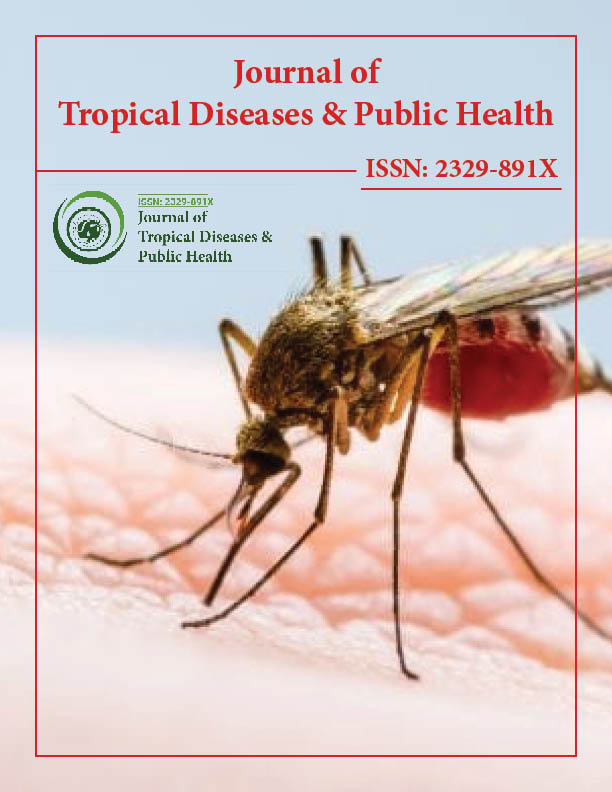Indexed In
- Open J Gate
- Academic Keys
- ResearchBible
- China National Knowledge Infrastructure (CNKI)
- Centre for Agriculture and Biosciences International (CABI)
- RefSeek
- Hamdard University
- EBSCO A-Z
- OCLC- WorldCat
- CABI full text
- Publons
- Geneva Foundation for Medical Education and Research
- Google Scholar
Useful Links
Share This Page
Journal Flyer

Open Access Journals
- Agri and Aquaculture
- Biochemistry
- Bioinformatics & Systems Biology
- Business & Management
- Chemistry
- Clinical Sciences
- Engineering
- Food & Nutrition
- General Science
- Genetics & Molecular Biology
- Immunology & Microbiology
- Medical Sciences
- Neuroscience & Psychology
- Nursing & Health Care
- Pharmaceutical Sciences
Perspective - (2025) Volume 14, Issue 2
Influence of Agricultural Irrigation on Malaria Distribution Patterns in Semi-Arid Tropical Regions
Karim Ansah*Received: 26-May-2025, Manuscript No. JTD-25-29790 ; Editor assigned: 28-May-2025, Pre QC No. JTD-25-29790 (PQ); Reviewed: 11-Jun-2025, QC No. JTD-25-29790 ; Revised: 18-Jun-2025, Manuscript No. JTD-25-29790 (R); Published: 25-Jun-2025, DOI: 10.35241/2329-891X.25.13.473
Description
The expansion of irrigated agriculture in semi-arid regions has significantly altered ecological conditions, creating environments that facilitate the spread of malaria. Once limited by seasonal water availability, the presence of year-round irrigation channels, rice paddies, and artificial ponds has extended the active season for Anopheles mosquitoes in several regions. This development introduces new challenges for public health systems in countries already contending with vector-borne diseases.
Several studies have noted that irrigation increases the abundance of mosquito breeding sites, particularly in communities located near open canals or waterlogged fields. These water bodies, often left untreated, serve as excellent habitats for mosquito larvae. Unlike ephemeral rain-fed pools, which dry up within days, irrigation-related standing water persists longer and supports repeated mosquito reproduction cycles. As a result, transmission windows are no longer confined to the rainy season but instead span much of the year.
This shift has affected the timing and intensity of malaria cases. In areas such as northern Ghana and southern Ethiopia, agricultural expansion through irrigation projects has led to year-round malaria transmission. Local health clinics report higher outpatient visits during months that were previously classified as low-risk periods. This continuous presence of the disease strains health services and makes long-term control strategies more difficult to implement, especially when vector control programs are still scheduled based on outdated seasonal models.
Compounding the issue, many irrigation systems are built without adequate drainage or vector management components. Overflow from canals, seepage into ditches, and mismanagement of sluice gates lead to pooling of water in nearby residential areas. These stagnant pools are particularly dangerous when located close to homes, as they increase the probability of human-vector contact. Villages situated within two kilometers of major irrigation sites have been shown to carry higher malaria burdens than those further away, even when socio-economic indicators are similar.
Farmers themselves are at increased risk due to prolonged exposure during early morning and late evening work hours. Without protective clothing or mosquito repellents, they are often bitten repeatedly during these high-activity periods for mosquitoes. In many cases, awareness of personal risk remains low, and preventive measures are not routinely practiced. Women and children involved in fieldwork or nearby household chores face similar risks, especially in communities where domestic activities occur outdoors.
Public health strategies must take these environmental changes into account. Traditional approaches that focus only on indoor residual spraying or distribution of treated nets may not be sufficient in irrigation-heavy regions. Outdoor transmission, particularly in areas near fields and canals, requires supplementary measures such as larval source management and environmental modification. However, implementing these interventions requires collaboration between health ministries, agricultural agencies, and local governance structures coordination that is often lacking.
On a policy level, guidelines for irrigation project planning should include health impact assessments as a routine requirement. These assessments must evaluate not only the projected crop outputs and water management metrics but also the potential influence on vector ecology. Designs that integrate proper drainage, regular maintenance schedules, and community-based surveillance have shown better outcomes in reducing mosquito proliferation. In India and Sudan, pilot projects that included such features recorded measurable declines in malaria cases over a three-year period.
Conclusion
In conclusion, while irrigation brings clear benefits for agriculture and livelihoods, it also introduces public health concerns that require deliberate attention. Without coordinated planning and sustained intervention, the unintended consequences of irrigation can significantly increase the burden of malaria in semi-arid regions. Future agricultural development must be aligned with vector control strategies that reflect current ecological realities. Otherwise, efforts to reduce malaria incidence may be undermined by the very infrastructure meant to support economic and food security.
Citation: Ansah K (2025). Influence of Agricultural Irrigation on Malaria Distribution Patterns in Semi-Arid Tropical Regions. J Trop Dis. 13:473.
Copyright: © 2025 Ansah K. This is an open-access article distributed under the terms of the Creative Commons Attribution License, which permits unrestricted use, distribution and reproduction in any medium, provided the original author and source are credited.

